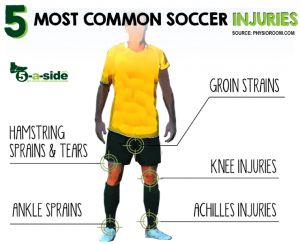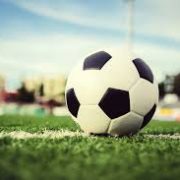Common Football/Soccer Injuries and How to Prevent Them
Another world cup is here! With soccer season in full swing, it’s important to take care of yourself. Whether you are a pro athlete, a weekend warrior, or anything in between, if you play soccer, you need to take care of your body.
Injuries to the lower extremities are the most common in soccer players. These injuries are generally defined as either cumulative (overuse) or acute (traumatic) injuries.
Overuse injuries occur over time due to stress on the muscles, joints, and soft tissues without proper time for healing. They begin as a small, nagging ache or pain, and can grow into a debilitating injury if they aren’t treated early.
Acute or traumatic injuries occur due to a sudden force, or impact, and can be quite dramatic.
Common Football Injuries

Ankle Sprains: The most common of all ankle injuries, an ankle sprain occurs when there is a stretching and tearing of ligaments surrounding the ankle joint.
Achilles Tendonitis: Achilles tendonitis is a chronic injury that occurs primarily from overuse and it felt as pain in the back of the ankle. If this is ignored it may increase your risk of Achilles tendon rupture.
Groin Pull: A groin (adductor) pull or strain occurs when the muscles of the inner thigh are stretched beyond their limits.
Hamstring Pull, Tear, or Strain: Hamstring injuries are common among runners and can range from minor strains to total rupture of the muscle at the back of the thigh.
Knee Injuries:
- Anterior Cruciate Ligament (ACL) and posterior cruciate ligament (PCL) injuries
- Medial Collateral Ligament (MCL) and lateral collateral ligament (LCL) injuries
Ligament injuries to the knee are very common in sports that require stopping and starting or quickly changing directions.
Cruciate ligament injuries don’t always cause pain, but typically cause a loud “pop.” Most of these injuries are confirmed with an MRI. Arthroscopic surgery is sometimes the best way to find a partial tear.
Torn Knee Cartilage (Meniscus Injuries): Torn knee cartilage is usually a torn meniscus.
These small, “C” shaped pieces of cartilage act as cushions between the thigh bone (femur) and the tibia (shin bone). Meniscus tears are often the result of twisting, pivoting, decelerating, or a sudden impact. It can be identified by various manual tests a physician can perform to detect torn cartilage.
How to Prevent Injuries
As mentioned above, some injuries are from bad management and some are from bad luck. For the purposes of this article, we will focus on the things you can do to prevent overuse injuries.
Maintain Fitness
Be sure you are in good physical condition at the start of soccer season. During the off-season, stick to a balanced fitness program that incorporates aerobic exercise, strength training, and flexibility. If you are out of shape at the start of the season, gradually increase your activity level and slowly build back up to a higher fitness level.
Warm Up
Always take time to warm up and stretch, especially your hips, knees, thighs, and calves. Research studies have shown that cold muscles are more prone to injury. Warm-up with jumping jacks, stationary cycling or running or walking in place for 3 to 5 minutes. Then slowly and gently stretch, holding each stretch for 30 seconds.
Check out the FIFA 11+ which has shown to prevent injuries in soccer.
Here is Part 1 of 11
Here is Part 2 of 11
Cool Down
Stretching at the end of practice is too often neglected because of busy schedules. Stretching can help reduce muscle soreness and keep muscles long and flexible. Be sure to stretch after each training practice to reduce your risk for injury.
Hydrate
Even mild levels of dehydration can hinder athletic performance. If you have not had enough fluids, your body will not be able to effectively cool itself through sweat and evaporation.
Sports Massage
It’s the best way to aid recovery in your exercise program. Helps improve circulation, improve range of motion, shorten recovery time, prevent and even heal injuries.
Benefits from Sports Massage
The sports massage actually came from the Swedish massage technique. Geared specifically to the athlete, this massage focuses on muscles that have seen a large degree of stress and use, often to the point of overuse. Normally, these are muscles that have seen repetitive and aggressive movement as a part of the overall sport or competition.
Sports massage is recognized by many in the training industry as an accepted component of an overall regimen of training and competition. This means the athlete can enhance pre-competition and reduce the required recovery period, which means a better and more intensive training session after a competition. Flexibility, a necessary component of any athletic completion, is also a part.
Many do not realize it, but sports massage has certain characteristics that make it ideal for athletes. The targeting of the muscle and tendons within the body is key for athletic training. There are several key elements to sports massage. To better understand each of these, let’s look at them separately.
Reduce muscle tension by decreasing muscle stiffness and soreness after exercise
Massage can alleviate muscle pain. If an athlete is stiff and sore due to an injury or working hard, he or she will not be performing at their peak with regular massage, muscle pain can be curbed and the athlete can perform at peak without being distracted by pain or injury. This occurs by removing lactic acid buildup in the muscle and stripping the muscle of any other toxins.
Helps prevent injuries
Consistent massage increases flexibility which leads to an increase in the range of motion a muscle requires. For an athlete to maintain optimal performance, they must have a high degree of flexibility. No matter which sport or sports the athlete is involved in, if a client can gain more flexibility from massage, then they will have an advantage over their competitors since massage stretches the muscle fibres, flexibility is promoted and maintained.
Improves blood and movement circulation
With better circulation, the athlete can breathe easier and move more smoothly. Since the practice of massage helps with blood flow, pumping it back to the heart quicker to me oxygenated thus improving an athlete’s performance.
Dilates the blood vessels supplying fresh nutrients
Massage acts to dilate the blood vessels which increases the efficiency of both supplying fresh nutrients to the tissues and eliminating metabolic wastes out of the body at a faster rate.
Helps drain sluggish lymphatic material
Massage acts as a mechanical cleanser, helping to drain sluggish lymphatic material. Good lymphatic circulation is very important for ridding the body of toxic materials like lactic acid build-up and calcium which are commonly known as ‘knots’.
Improves muscle tone
Massage improves muscle tone by mechanically stimulating inherent reflexes found within muscle fibres. (This is particularly important to those who do not obtain adequate daily exercise due to a sedentary lifestyle or long periods of convalescence.)
Prevents adhesions
When muscle fibres start to adhere together it restricts their full range of motion. Transverse massage strokes help to prevent adhesions from occurring in between the muscle fibres, again these adhesions are commonly known as knots. Adhesions build up bigger and the muscle cannot do its job to the best of its ability with the restriction stopping the flexibility in the muscle. Eg. The muscle’s belly becomes short and tight.
If you would like to book in for a sports massage to help with your recovery, give our office in North Sydney a call 02 9955-5110. Alternatively, you can book online here.

